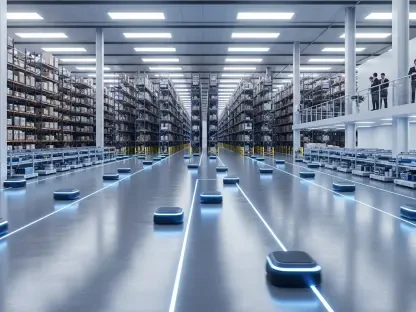In a striking reaction to President Donald Trump’s aggressive tariff threats designed to ramp up domestic production, pharmaceutical powerhouses are channeling billions into expanding manufacturing within the United States, signaling a major shift in response to political pressure. Industry leaders such as AstraZeneca, Johnson & Johnson, and Eli Lilly have collectively committed over $250 billion to construct or enhance facilities across the nation. The administration hails these investments as a triumph for American job creation and a step toward securing the nation’s drug supply chain against foreign vulnerabilities. Yet, beneath the surface of these headline-grabbing figures lies a web of uncertainty. Will these financial pledges truly diminish reliance on overseas production, and can they deliver the lower drug prices promised to consumers? As this unprecedented wave of investment unfolds, a closer examination reveals a complex interplay of policy, economics, and global realities that may temper the ambitious goals set by tariff-driven strategies.
Unpacking the Surge in Domestic Investment
The driving force behind this massive influx of capital into U.S. manufacturing stems from Trump’s tariff policies, which aim to penalize foreign production and incentivize companies to prioritize American soil for their operations. The White House, through figures like Commerce Secretary Howard Lutnick, has positioned these commitments as direct evidence of the effectiveness of such economic pressures, framing them as a boost to both employment and national resilience. With over $250 billion on the table from major players in the pharmaceutical sector, the scale of investment appears staggering at first glance. However, a deeper dive suggests that not all of these pledges are entirely new or solely motivated by the latest tariff threats. Some announcements echo earlier plans or seem crafted to align with political narratives, raising questions about the depth of transformation actually taking place within the industry’s operational framework.
Beyond the political fanfare, industry analysts offer a more cautious perspective on the motivations and long-term implications of these financial moves. While the administration celebrates the investments as a policy win, there’s skepticism about whether they represent genuine shifts in strategy or merely symbolic gestures to appease regulatory scrutiny. The pharmaceutical landscape is not easily reshaped by tariff threats alone, as companies must weigh the costs of relocating complex operations against the benefits of domestic favor. For brand-name drugmakers with substantial profit margins, adapting to these pressures might be feasible, but the broader industry faces significant hurdles. This dichotomy between public perception and corporate reality underscores the need to look beyond dollar amounts and examine how these investments align with the overarching goals of reducing foreign dependency and enhancing economic stability in the U.S. healthcare system.
Navigating the Global Supply Chain Maze
The pharmaceutical supply chain’s global nature presents a formidable barrier to achieving the self-sufficiency envisioned by tariff policies. Production often spans multiple continents, with raw materials sourced from one country, active ingredients processed in another, and final products assembled elsewhere. Brand-name drugmakers, benefiting from higher revenues, can more readily absorb the costs of shifting some operations to the U.S. In contrast, generic drug producers, responsible for over 90% of prescriptions filled in the country, operate on much slimmer margins. A significant portion of generic drugs, particularly in pill and capsule forms, is manufactured overseas, with India playing a dominant role. This deep-rooted international dependency complicates any attempt to fully localize production, as the infrastructure and cost structures abroad are often more favorable than domestic alternatives.
National security concerns further amplify the stakes of this global reliance, especially for critical generic medications used in emergency and hospital settings. Lawmakers across party lines have voiced alarm over potential supply chain disruptions during geopolitical tensions or global crises, highlighting the risks of depending on foreign sources for essential drugs. Yet, experts argue that tariffs alone are unlikely to catalyze a meaningful shift toward domestic manufacturing for generics without substantial government-backed incentives or subsidies. The ambiguity surrounding which specific products or countries will face tariff penalties adds another layer of difficulty for companies attempting to plan long-term investments. As a result, while the push for U.S.-based production is clear in intent, the practical challenges of untangling a worldwide supply network remain a persistent obstacle to achieving true independence.
The Pricing Paradox of Domestic Production
A core objective of Trump’s tariff strategy is to reduce drug prices for American consumers by bringing manufacturing back home, but the reality may not align with this aspiration. Operating facilities in the U.S. typically incurs higher labor and regulatory costs compared to many foreign markets, and these expenses are unlikely to vanish simply because production shifts geographically. The intricate web of pricing in the healthcare system, involving negotiations between manufacturers, insurers, and pharmacy benefit managers, often means that increased costs are ultimately borne by patients through elevated out-of-pocket expenses or insurance premiums. For brand-name drugs, companies might absorb some of these costs to maintain market share, but the likelihood of passing on price hikes remains high, casting doubt on the promise of affordability.
The situation grows even more precarious for generic drugs, where profit margins are already razor-thin, leaving little room to maneuver when production costs rise. If forced to manufacture domestically under higher cost structures, many generic producers might choose to exit the U.S. market altogether, a move that could exacerbate existing drug shortages and limit access to vital medications. This creates a troubling paradox: while the intent of tariffs is to safeguard American interests by fostering local production, the unintended consequence could be reduced availability or higher prices for the very consumers these policies aim to protect. Without addressing the systemic factors that drive drug pricing, simply relocating manufacturing may fail to deliver the financial relief anticipated by policymakers and the public alike.
Security Concerns and Policy Shortfalls
The vulnerability of relying on foreign pharmaceutical supplies has emerged as a critical national security issue, particularly as the U.S. grapples with ensuring a steady flow of essential drugs during potential crises. The dependence on overseas production for generics, which are indispensable in medical settings, has drawn bipartisan concern, with lawmakers urging action to mitigate risks of supply interruptions. Tariffs are positioned as a tool to encourage domestic manufacturing, yet they fall short of addressing the full scope of this challenge. Without tailored policies or financial incentives to specifically target the generic sector, the goal of self-reliance remains elusive, leaving the nation exposed to uncertainties in global supply dynamics that could jeopardize public health.
Compounding these issues is the reality of time and policy unpredictability, which hinders immediate progress toward supply chain security. Building new manufacturing facilities is a process that often spans three to five years, meaning that even the most ambitious current investments won’t yield results overnight. Additionally, the lack of clarity on future tariff structures or potential shifts in political leadership creates hesitation among drugmakers to fully commit to large-scale domestic projects. This uncertainty, paired with the economic disparities between brand-name and generic production, suggests that while the administration’s focus on national security is well-founded, the tools currently deployed may not suffice. A more comprehensive approach, blending tariffs with strategic support, appears necessary to bridge the gap between policy intent and tangible outcomes.
Reflecting on the Path Forward
Looking back, the substantial investments by pharmaceutical giants in U.S. manufacturing marked a pivotal moment in response to tariff pressures, yet they also exposed deep-seated challenges within the industry. The commitment of over $250 billion by major companies was a testament to the influence of political strategy, but it fell short of guaranteeing reduced foreign dependency or lower consumer costs. The intricate global supply chain, pricing complexities, and national security risks underscored the limitations of relying solely on tariffs to reshape the landscape. Moving ahead, a more nuanced framework could be essential, one that combines economic incentives with targeted reforms to support both brand-name and generic sectors. Addressing systemic pricing mechanisms and offering clearer policy guidance might help align corporate actions with national goals, ensuring that future efforts not only bolster domestic production but also safeguard access and affordability for all Americans.









